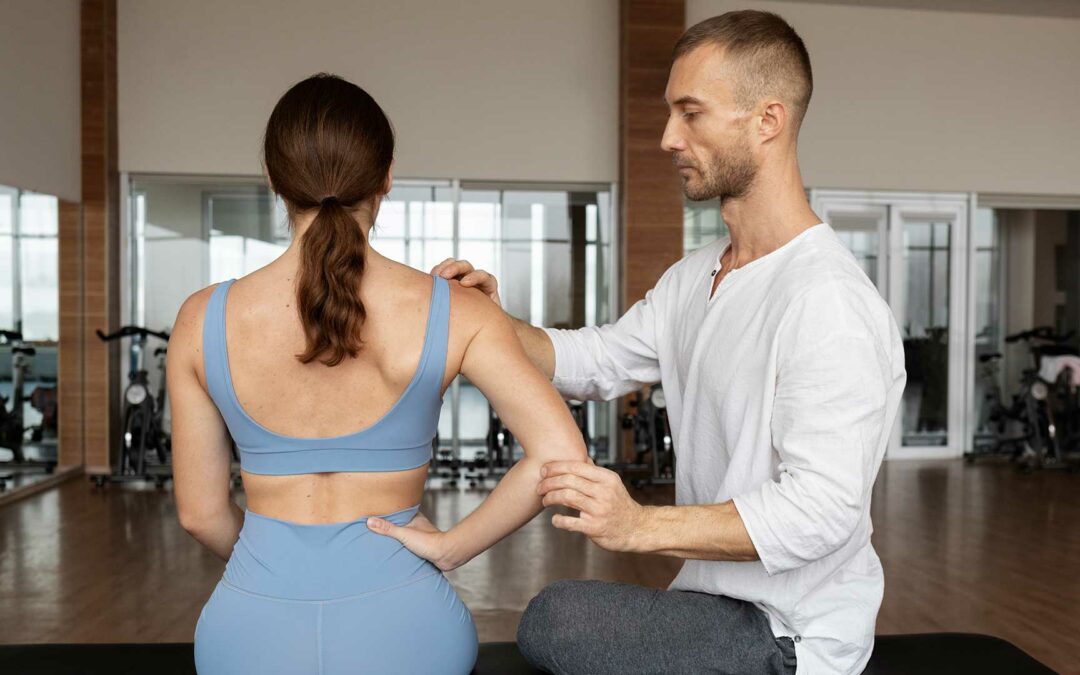What is Banded Wall Climbs Exercise?
Banded wall climbs exercise is a functional exercise that targets the rotator cuff muscles and scapular stabilizers. This exercise imitates climbing movements and positions, making it an excellent exercise for climbers and individuals who perform overhead activities. Banded wall climbs exercise involves wrapping a resistance band around the wrist and performing a climbing motion while standing facing a wall.
Banded wall climbs exercise can improve rotator cuff strength and endurance, shoulder range of motion, and scapular stability. This exercise is also highly effective in preventing shoulder injuries and improving overall shoulder function.
Compared to other shoulder exercises, banded wall climbs exercise is unique in that it involves a combination of movements, including shoulder external rotation, shoulder abduction, and scapular upward rotation. By combining these movements, banded wall climbs exercise targets multiple muscles simultaneously, making it an efficient exercise for shoulder rehabilitation.
Purpose of Banded Wall Climbs
Banded wall climbs serve several fitness and rehabilitation purposes:
- Shoulder Stability and Strength:
- Banded wall climbs specifically target the muscles around the shoulders, including the deltoids and upper traps. The resistance provided by the band helps build strength in these muscles, promoting shoulder stability.
- Core Activation:
- As you lift and step each hand out while maintaining a stable torso against the wall, the core muscles are engaged. This exercise promotes core activation and strength, contributing to overall stability.
- Functional Upper Body Strength:
- The controlled movement of stepping hands apart and lifting them alternately mimics real-world functional activities. This exercise helps develop practical upper body strength, enhancing your ability to perform daily tasks.
- Rehabilitation and Mobility:
- Banded wall climbs are often incorporated into rehabilitation programs for individuals recovering from shoulder injuries. The controlled nature of the movement aids in improving shoulder mobility while strengthening the surrounding muscles.
- Posture Improvement:
- By focusing on drawing the shoulder blades down and in, banded wall climbs encourage proper shoulder and neck alignment. This can contribute to better posture and help alleviate tension in the neck and shoulders.
- Versatile Exercise:
- Whether you’re an athlete looking to enhance upper body strength or someone recovering from an injury, banded wall climbs can be adapted to different fitness levels. The resistance band allows for progression by adjusting tension.
In summary, banded wall climbs offer a holistic approach to upper body strength, stability, and rehabilitation, making them a valuable addition to fitness routines under proper guidance.
How to Perform Banded Wall Climbs Exercise
When performing banded wall climbs exercise, it’s crucial to maintain proper form to avoid injury and achieve maximum benefit. Here are the steps to perform banded wall climbs exercise correctly:
- Place the resistance band across both wrists and face a wall.
- Position the sides of both hands against the wall at shoulder height.
- Gently draw your shoulder blades down and in towards your waist to relax the neck and shoulders.
- Step the hands apart to increase the tension in the band.
- Lift and step each hand out alternatively to the sides, finishing with both arms spread apart above your head.
- Control the movements and reverse them to come back down the wall.
- Ensure your hands stay wider than your elbows as you step them out.
- Avoid shrugging your shoulders; maintain a gentle squeeze on your shoulder blades throughout the movement.
- Focus on stepping the arms and shoulders up; avoid rotating your trunk or stepping away from the wall.
- Do not hold your breath during the exercise; breathe consistently.
- Complete the movement within your comfort and pain tolerance, following advice from your physiotherapist.
It’s essential to avoid common mistakes when performing banded wall climbs exercise, such as using too heavy of resistance band, moving the arm too quickly, or not maintaining a stable shoulder blade.
Muscles Worked with Banded Wall Clims
Banded wall walks primarily target the following muscle groups:
- Deltoids (Shoulders):
- The exercise engages the deltoids, promoting shoulder stability and strength. This is essential for maintaining proper shoulder function and preventing injuries.
- Upper Trapezius:
- The upper trapezius are activated during banded wall walks, contributing to shoulder elevation and support. Strengthening this muscle group can be beneficial for individuals with postural issues or neck tension.
- Core Muscles:
- Banded wall walks require core engagement to stabilize the spine and pelvis. This contributes to improved overall core strength, aiding in posture and preventing lower back issues.
- Arm Muscles:
- Muscles in the arms, including the biceps and triceps, are involved in the lifting and controlled movement of the hands during the exercise. This can contribute to improved arm strength and endurance.
- Scapular Stabilizers:
- The exercise encourages the activation of scapular stabilizers, including the rhomboids and serratus anterior. This is crucial for maintaining proper scapular movement, reducing the risk of shoulder injuries.
By targeting these muscle groups, banded wall walks on the Merlin Physio App offer a comprehensive approach to upper body and core strengthening, aiding in rehabilitation, mobility, and overall functional fitness. As always, individual variations in muscle engagement may occur, and users are advised to consult with their physiotherapist through the app for personalized guidance based on their specific needs and conditions.
Use of Merlin PT for Banded Wall Climbs
In today’s fast-paced world, Merlin Physio app is a game-changer for physiotherapists and clinics. This user-friendly app is designed to simplify the lives of physiotherapists, allowing them to track their patients’ progress with ease. No more cumbersome paperwork and endless files to flip through – Merlin Physio app puts all the patient’s details right at your fingertips.
One of the most significant advantages of this app is its ability to save time and costs by eliminating unnecessary delays. With Merlin, you can say goodbye to long queues at the front desk and reduce the wait time for your patients. This means more efficient appointments, happier patients, and a smoother workflow for your clinic.
But Merlin Physio app isn’t just about streamlining administrative tasks. It’s a self-management tool that empowers patients to take control of their health and well-being. By providing real-time feedback and guidance, the app helps prevent long-term health degradation. Patients can monitor their progress, follow exercise routines, and stay on track with their treatment plans.
Imagine a world where physiotherapy is not just about visits to the clinic but an ongoing partnership between therapists and patients. Merlin Physio app makes this vision a reality. It fosters a sense of accountability and engagement among patients, resulting in better, more sustainable results.
In conclusion, Merlin Physio app is a revolutionary tool that revolutionizes the way physiotherapists and clinics operate. It simplifies record-keeping, reduces costs, and most importantly, empowers patients to take an active role in their healing journey.
Pros and Cons of Banded Wall Climbs Exercise
Here are some pros and cons of banded wall climbs exercise:
| Pros | Cons |
|---|---|
| Targets multiple muscles simultaneously | Can be difficult for beginners |
| Mimics climbing movements and positions | Requires a resistance band |
| Improves rotator cuff strength and endurance | Can cause injury if not performed correctly |
| Improves shoulder range of motion and scapular stability | May require supervision from a professional |
Conclusion
In conclusion, banded wall climbs exercise is an excellent exercise for shoulder injury rehabilitation. This exercise targets multiple muscles simultaneously and imitates climbing movements, making it highly effective for climbers and individuals who perform overhead activities. It’s crucial to perform this exercise correctly, gradually increase intensity, and seek professional advice before beginning any new exercise program. A physiotherapy app can be an excellent tool to aid individuals in their shoulder injury rehabilitation journey.

